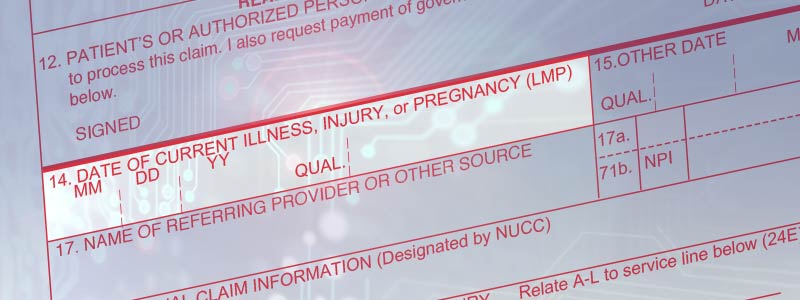
Mario Fucinari DC, CCSP, CPCO
Recently, Medicare announced they will be beginning a new round of Medicare audits. Medicare audits continue as part of the contractor’s responsibilities. While it’s true that typically they are just “fishing,” certain information you send in with your claims may trigger an audit. One of these items is the date in Box 14. Even in conventional insurance, box 14 is still a pertinent piece of information that is needed in the case.
The claim form is a useful tool to communicate with the insurance carrier. If used properly, Box 14 of the claim form will give information that will answer questions, before they arise. If used improperly, it will most probably lead to denial and a possible audit.
Box 14 of the claim form asks for the date of onset, injury or date of the last menstrual period (LMP). The LMP is used only for obstetrics. In the claim form box 14 also contains a space for a qualifier (Qual). Depending on the carrier, the box 14 will usually require the qualifier “431”, which indicates that it is the date of onset or injury. In Medicare, Box 14 is used to indicate the date the patient first began treatment in your office for the diagnosis listed in line A of Box 21. Since in Medicare the date is neither the date of the onset nor the LMP, you do not use a qualifier.
The date in Box 14 also should be updated if an exacerbation of the condition occurs. The definition of exacerbation, according to Medicare is, “An acute exacerbation is a temporary but marked deterioration of the patient’s condition that is causing significant interference with activities of daily living due to an acute flare-up of the previously treated condition.”
The Comprehensive Error Rate Testing Program (CERT) consistently ranks maintenance care, a non-covered service, as one of the top three errors in Medicare. Blue Cross is looking for maintenance care as an offender as well. Whether the date is the onset of injury or the date that you first began treating the patient for a certain condition, you can see that if the date has not been updated as indicated, it could trigger an audit. Especially in Medicare, if the date is over 90 days old, it indicates that you have been treating the patient for over 90 days for the condition. While this is possible, your documentation must support the continuing care. You can understand where the care may be viewed as maintenance care.
The only case where you never want to update or change the date in Box 14 is in a personal injury or worker’s compensation case. In these types of cases, the date in Box 14 indicates when the accident occurred. Changing the date while the case is progressing would indicate that another injury has occurred. This will usually trigger a questionnaire to see if there is another source of injury.
Your first line of communication to a carrier is the claim form. Clear communication is one step toward unencumbered reimbursement. It is imperative that the doctor and staff are aware of information that reviewers are looking for in an audit. Internal monitoring and self-audit of records before they are sent to the carrier will decrease denials, ensure proper reimbursements and decrease recoupment.
Dr. Fucinari is a frequent lecturer for ChiroHealthUSA, NCMIC, and Foot Levelers. Dr. Fucinari is a Certified Professional Medical Compliance Specialist. The required OIG Compliance Manual for Medicare is now available at www.Askmario.com. For further information on compliance audits, manuals or record reviews, please contact Dr. Fucinari at Doc@Askmario.com.









 ▶︎
▶︎  Why is the Discount Challenge prize amount $15,024? Because that is the average “per-occurrence” fine for Medicare inducements. That’s not $15,024 per patient, that’s not per provider, that’s PER VISIT. Stinks, doesn’t it? To us, the prize amount is worth the investment if we can help our profession better understand proper discounting.
Why is the Discount Challenge prize amount $15,024? Because that is the average “per-occurrence” fine for Medicare inducements. That’s not $15,024 per patient, that’s not per provider, that’s PER VISIT. Stinks, doesn’t it? To us, the prize amount is worth the investment if we can help our profession better understand proper discounting.